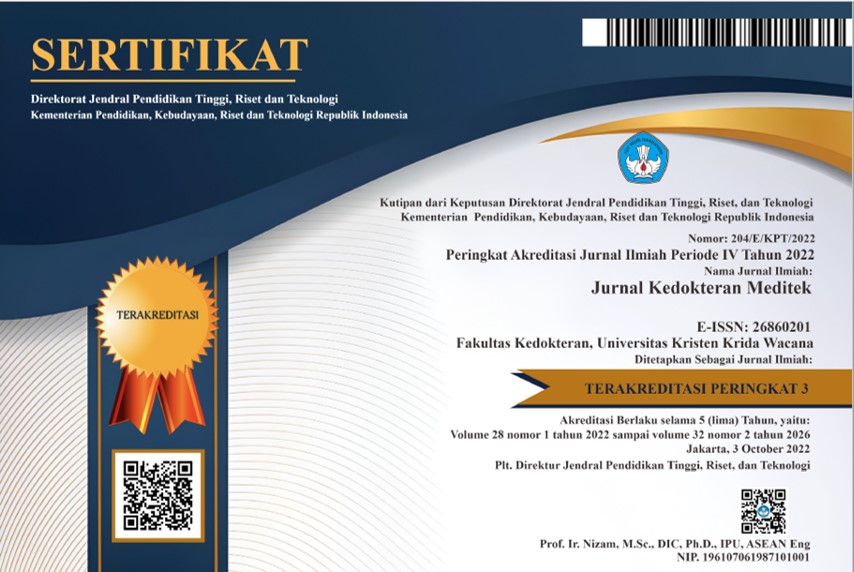Hubungan Berat Badan dengan Kualitas Tidur pada Mahasiswa Fakultas Kedokteran dan Ilmu Kesehatan, Universitas Kristen Krida Wacana Angkatan 2016
DOI:
https://doi.org/10.36452/jkdoktmeditek.v26i2.1847Keywords:
body mass index, sleep apnea, sleep quality.Abstract
Overweight is an independent factor that contributes to poor sleep quality. Sleep apnea is abnormal breathing associated with constriction of the upper airway during sleep. Sleep apnea can be in the form of apnea or decreased ventilation leading to breathing problems during sleep. The higher the value of the Body Mass Index (BMI) or weight gain, the higher the possibility to experience Obstructive Sleep Apnea (OSA). The purpose of this study was to determine the relationship between BMI and sleep quality among medical students of Ukrida from class of 2016. The study was based on a cross sectional approach and subjects were determined based on a purposive sampling technique. Eighty-eight medical students of Ukrida from 2016 intake completed the Pittsburgh Sleep Quality Index assessment. Chi-Square test was used to analyze the relationship between BMI with sleep quality in overweight and normal weight students. Forty-four respondents were of normal weight, whereas 44 were overweight. Results showed 64 respondents (72.7%) had poor sleep quality, and 24 respondents (27.3%) had good sleep quality. Most of the respondents had sleep duration of <6 hours. Chi square analysis found that BMI was related with sleep quality (p = 0.000, p < 0.05) among the students participated in this study.
References
2. Hruby A, Hu FB. The epidemiology of the obesity: a big picture. Pharmacoeconomics. 2015;33(7):673-89.
3. Kementrian Kesehatan RI. Laporan riset kesehatan dasar nasional. 2010. Available at: www.litbang.depkes.go.id (diakses 2 Nov 2018)
4. Bannno K, Kryger MH. Sleep Apnea: Clinical Investigation in Human. Sleep Medicine. 2007; 8:400-26.
5. Schwartz AR, Schwartzl, Susheel P, Alison M, Laffani L, et al. Obesity and obstructive sleep apnea pathogenic mechanism and therapeutic approaches. Proceed of the American Thoracic Society. 2008; 5:185-92.
6. Sumardi, Hisjam B S, Budiono E. Sleep apnea. Dalam: Sudoyo AW, Setiyohadi B, Alwi I, et al., penyunting. Buku ajar ilmu penyakit dalam jilid II. Edisi VI. Jakarta: Internal Publishing. 2014. p.1700-3.
7. Fenny & Supriatmo, Hubungan kualitas dan kuantitas tidur dengan prestasi belajar pada mahasiswa Fakultas Kedokteran. Jurnal Pendidikan Kedokteran Indonesia. 2016;5(3):140-7.
8. Roenneberg T, Kuehnle T, Juda M, et al. Epidemiology of the human circadian clock. Sleep Medicine Reviews, [online]2007;11(6):429-38. Tersedia pada: https://www.ncbi.nlm.nih.gov/pubmed/17936039 [Akses 18 Oct. 2019].
9. Souza LC, Rodrigues J, Rotenberg L. Epidemiology of insomnia: prevalence and risk factors. can't Sleep? Issues of being an insomniac. 2012. Tersedia pada: https://www.intechopen.com/books/can-t-sleep-issues-of-being-an-insomniac/epidemiology-of-insomnia-prevalence-and-risk-factors. [Akses 18 Oct. 2019].
10. Rebbapragada V, Subramanian S, Chanamolu, S, et al. Insomnia in obstructive sleep apnea: prevalence and gender and ethnic variance. Sleep Medicine. 2006;7:118-9. Tersedia pada:http://www.sleepjournal.com/article/S1389-9457(06)00506-5/abstract. [Akses 18 Oct 2019]
11. Park S. Association between short sleep duration and obesity among South Korean adolescents. Western Journal of Nursing Research. 2010;33(2):207-23.
12. Utami NP, Purba MB, Huriyati E. Hubungan durasi tidur terhadap asupan energi dan obesitas pada remaja SMP di Kota Yogyakarta. Seminar Nasional Gizi 2017. Program Studi Ilmu Gizi UMS 29 “Strategi Optimasi Tumbuh Kembang Anak” ;2017.
13. Prayudo P. Durasi tidur singkat dan obesitas. Jurnal Majority Fakultas Kedokteran Universitas Lampung; 2015.
14. Kementrian Kesehatan Republik Indonesia. Kebutuhan tidur sesuai usia. 2015:1-2.
15. Cicik S. Beberapa faktor yang berhubungan dengan kualitas tidur pada mahasiswa fakultas kesehatan masyarakat Universitas Diponegoro Semarang. Jurnal Kesehatan Masyarakat Universitas Diponegoro. 2012;1(2):280-92.
16. Nugroho T. Perbedaan kuantitas tidur pada remaja yang obesitas dan yang tidak mengalami obesitas di SMA Negeri 2 Demak 2016. (cited 1 Oct 2019]. Available from: https://docplayer.info/39538320-Perbedaan-kuantitas-tidur-pada-remaja-yang-mengalami-obesitas-dan-yang-tidak-mengalami-obesitas-di-sma-negeri-2-demak-artikel-ilmiah.html.
17. Saputra, M. Studi komparasi kualitas tidur anak obesitas dan tidak obesitas pada anak di SD Negeri Serang Sendangsari Pengasih Kulon Progo. Ilmu Keperawatan Sekolah Tinggi Ilmu Kesehatan Aisyiyah, Yogyakarta; 2014.
18. Ali A, Majeed MB, Saba K, Bodenarain A, Bukhari MH. Effects of different sleeping patterns on academic performance in medical school students. Natural Science. 2013;05(11):1193-8.
19. Mesquita G, Reimão R. Quality of sleep among university students: Effects of night time computer and television use. Arq Neuropsiquiatr. 2010;68(5):720-5.
20. Keswara UR, Syuhada N, Wahyudi WT. Perilaku penggunanan gadget dengan kualitas tidur pada remaja. Holistik Jurnal Kesehatan. 2019;13(3):233-9.

















